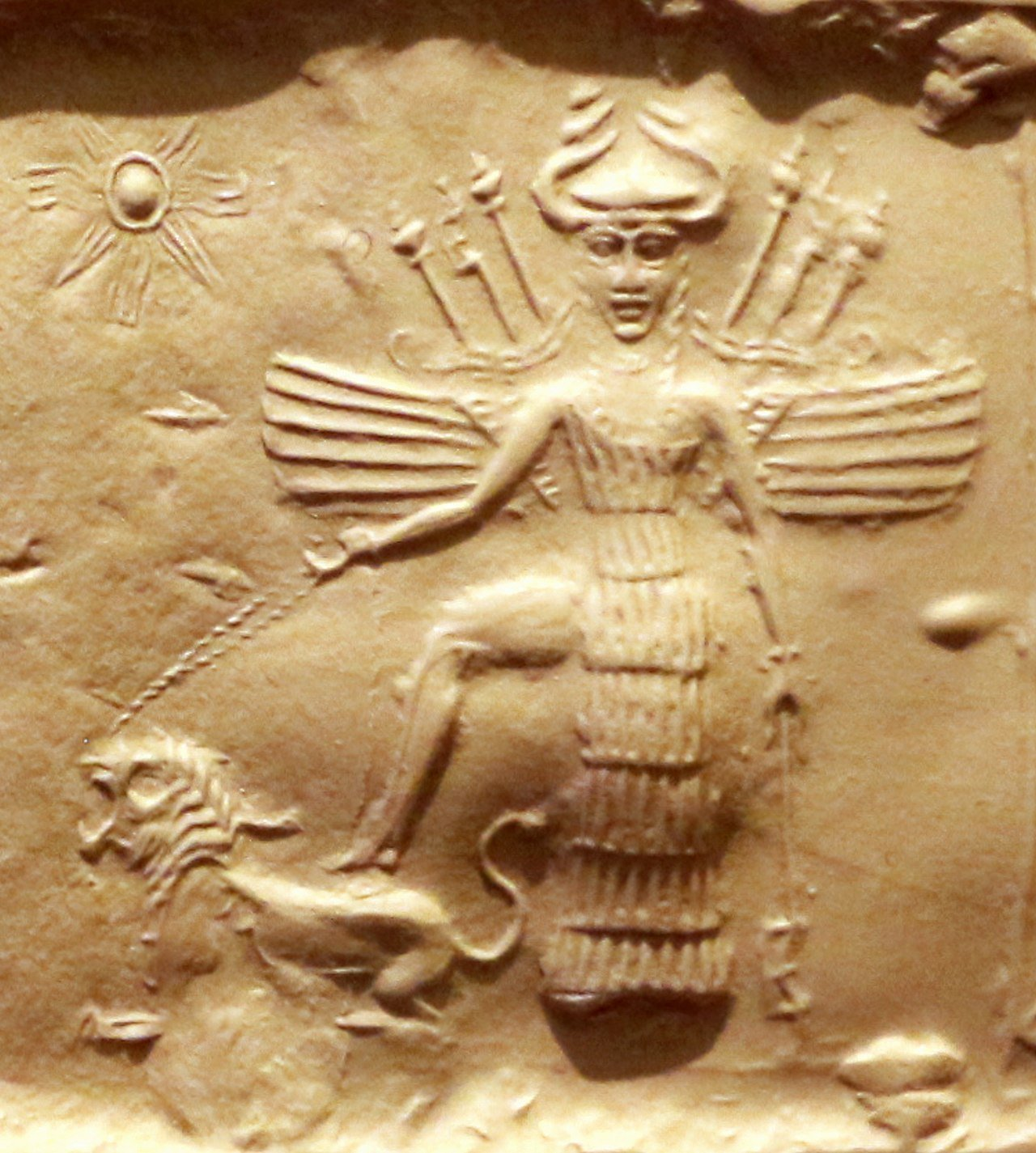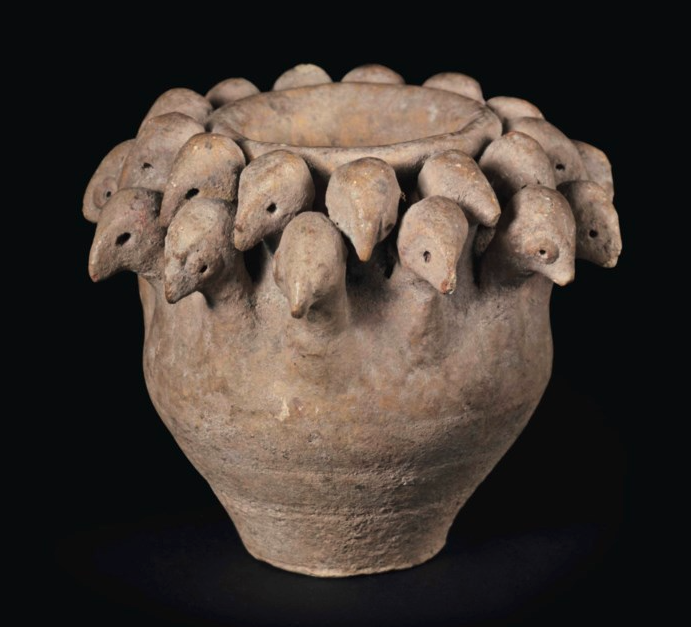Good morning. Old Assyrian (2000 BC-1800 BC) cylinder seal. Currently in the British museum...
Official description: Man in a chariot driving four horses; before him seven human heads and two birds; one other bird is above the two horses
Hmmm...
Quadriga in 2nd millennium BC Mesopotamia... Interesting...A man? Or a God? Like Sun god? They love horse drawn chariots...Like Helios depicted in his horse drawn quadriga on this Apulian vase dated to 350BC...
Why would sun gods like horses so much? The natural breeding season of horses starts in Apr/May and ends in Sep/Oct spanning the sunny, hot half of the year in the continental Eurasia, and is marked by wild stallion fights for mares...
The horse fertility is governed by the sunlight and peaks on summer solstice. I heard summer solstice was a big thing for sun worshipers....
Hence solar horses all over Eurasia...
Articles about solar horse (equid):
Iran "Water carrier equid", "Dioscuri plate from Iran"
Mesopotamia "Shamash playing with the solar horse", "Sun god from Tell Brak"
India "Hayagriva"
China "Longma", "Three legged crow", "Mythical beast from Xian"
Levant "Alexamenos graffito", "Goddess on a horse", "Unicorn"
Europe "Archaic rider", "Beotian solar pyxis", "Pegasus and chimera", "King John", "The horseman"
But the quadriga rider depicted on this Assurian seal can't be Helios...And his quadriga can't be pulled by horses...
He is most likely Sun God Shamash who was depicted on this 3rd mill BC cylinder seal imprint found in Tell Brak, Syria riding on a quadriga. Quadriga pulled not by horses but by "kungas", donkey hybrids so highly regarded, that "they were the preferred draught animal for drawing the chariots of kings and gods"... I talked about this in my post "Sun god from Tell Brak"...
Interestingly: In a letter dated to 1775 BCE, Bahdi-Lim, governor under the Mari king Zimri-Lim, insists that the king should not ride horses in his capital, as it was considered uncivilised. Instead, he urges the king to honour his royal status by riding in a donkey-drawn wagon...
From my post "Alexamenos graffito" about this:
Christ riding into Jerusalem on a donkey by Oleksandr Antonyuk.
Why did Jesus have to ride into Jerusalem on a donkey?
People say: He was fulfilling a scripture prophecy.
"Rejoice, O people of Zion! Shout in triumph, O people of Jerusalem! Look, your king is coming to you. He is righteous and victorious, yet he is humble, riding on a donkey" Zechariah 9:9
God/King riding on the favourite ride of the old Gods/Kings...
And this:
Christ is born on Winter Solstice, (re)birth day of the sun (god), he enters Jerusalem on a donkey, "animal of the (sun) gods and kings", and gets put on a cross, symbol of the sun (god)...Interesting...Early Christian "Alexamenos graffito", Rome.
Anyway, back to our Assyrian seal. Why 7 human heads? Maybe 7 months of Mesopotamia summer?
I talked about this first in my post "Seven headed dragon" The oldest depiction of a Hero(es) killing a 7 headed dragon dragon...Mesopotamia, 2200BC...With 7 snake heads...One for each hot month of Mesopotamian summer...They are killing the 4th head. Apr/May, May/Jun, Jun/Jul, Jul/Aug...
Leo...The time when Sirius rises with the sun..There is also a princess (Inanna/Ishtar) standing under a star (Sirius) 🙂...
I talked about Inanna/Ishtar as Sirius in many of my posts...
Same girl, same beast (summer)...
Woman of the Apocalypse...I gave Full symbolic analysis of the Chapter 12 of the Book of Revelation in my post "Apocalypse"...
Anyway, back to our Assyrian seal. Why birds? Originally I thought that maybe these are migratory birds, cause migratory birds announce the start and end of summer, the domain of the Sun god?
I talked about migratory birds in Mesopotamian mythology in my post "Nanshe'. In Sumerian mythology, Nanshe was the daughter of Enki (god of water) and Ninhursag (earth goddess). This 3rd Dynasty or Ur plaque depicts goddess Nanshe with geese.
This is because the arrival and departure of migratory geese marks the beginning and end of the wet half of the year in Mesopotamia. On the flip side the departure and the arrival of the migratory geese marks the beginning and the end of the dry half of the year in Mesopotamia.
But now, I am thinking that based on the shape of the birds they could actually be doves.
Dove was sacred to Inanna/Ishtar. 1800-1600 BC pottery cup, Syria. The rounded body tapering to a flat base, with 26 bird heads. Similar objects were interpreted as votive objects dedicated to Ishtar/Inanna, who was also linked to grain and doves.
The reason for that is that nesting season of doves overlaps with the grain harvest season.
Which brings me to: is that grain depicted just above the two birds? Right in front the chariot...
We know that this has been a grain symbol in Eastern Mediterranean, Mesopotamia, Central Asia, Iran, since at least Sumerian times...
I talked about this in many of my posts...
Mesopotamian harvest coincides with the beginning of summer (Apr/May), the beginning of the mating of wild donkeys and the beginning of summer, the domain of the Sun God...
Maybe I am just reading too much into this. Maybe it is a man, a king, riding triumphantly over severed heads of his enemies which are being pecked by vultures and ravens....That's kind of cool too...
PS: A 5,000-year-old toy chariot found during the excavations in the ancient city of Sogmatar in the southeastern Turkish province of Sanliurfa...With what looks like grain symbols?
To read more about ancient animal and plant calendar markers, start here…Then check my twitter threads I still didn't convert to blog post...I am way way behind...















Another chariot, from Serbia, with swastikas; and cave marks counting months til birth. https://www.facebook.com/share/p/19gahxyqtC/
ReplyDeletehttps://www.facebook.com/share/v/16zbUSa22R/